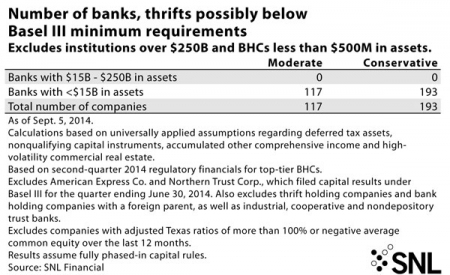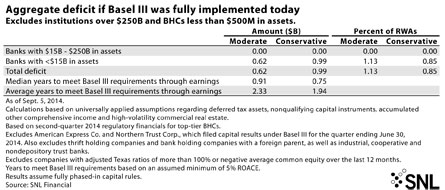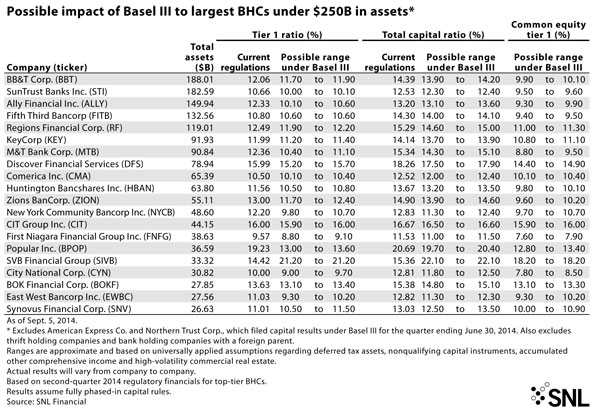Handful of small banks must catch up to Basel III
SNL Report: Most of industry in the green zone
- |
- Written by SNL Financial

By Nathan Stovall and Salman Aleem Khan, SNL Financial staff writers
While most banks are on strong footing to comply with the Basel III capital accords, a fairly sizable number of smaller institutions are still falling short just six months before the deadline to begin phasing in the rules.
Smaller institutions have made progress to comply with the Basel III rules over the last 12 months, but nearly 200 small banks still need to build their capital levels to meet the standards, according to an analysis by SNL Financial. Their larger counterparts have been better prepared to comply with the Basel III standards for quite a while, in part because they have less time to comply with the provision.
 For a larger version, click on the image.
For a larger version, click on the image.
Under the final Basel III rules, large, internationally active banks had to begin phasing in Basel III requirements in January 2014. Smaller institutions, including all S&Ls, will have to begin phasing in the Basel III capital in January 2015.
While banks have several years to reach full Basel III compliance, some advisers have cautioned that banks likely will need to show that they are moving toward full compliance even before the final effective date.
SNL has regularly measured banks' efforts to comply with the Basel III rules. SNL has measured the capital impact of the final Basel III rules by developing a template that examined two severity scenarios. The "conservative" and "moderate" scenarios took into account provisions outlined in the proposed rules, such as new risk-weightings of assets and new deductions of certain items from common equity Tier 1.
Methodology
To conduct the analysis, SNL developed a model that calculates capital ratios under Basel III. A range of assumptions were used to determine possible impacts to capital. All assumptions are universal and applied to each company. In actuality, assumptions will vary from company to company.
Under SNL's "moderate" analysis, no deferred tax assets are considered related to operating losses and tax credit carryforwards.
Concentration in high-volatility commercial real estate is estimated to be low. The "conservative" analysis categorizes a portion of deferred tax assets as related to operating losses and tax credit carryforwards. Concentration in high-volatility commercial real estate is estimated to be high.
The "moderate" and "conservative" scenarios include trust preferred and cumulative perpetual preferred securities in capital for banks permitted to "grandfather" them in their capital ratios. Both scenarios also assume all banks opt out of including accumulated other comprehensive income in capital. Assumptions under the aforementioned scenarios remained the same between the original and final rules where applicable.
Companies were considered to fall short of the Basel III requirements if they had a common equity Tier 1 ratio below 7%, a Tier 1 ratio below 8.5%, a total risk-based capital ratio below 10.5%, or a leverage ratio below 5%. Where applicable, these thresholds include the capital conservation buffer.
The analysis treats Basel III as if it were presently implemented; however, sections of it will be implemented over a multiple-year time frame.
Progress continues, but small banks falling short
SNL's most recent analysis found that the capital bases of large banks continue to be well-prepared for the implementation of the final Basel III rules. SNL's analysis did not include institutions with more than $250 billion in assets that are subject to the advanced approach of the Basel III rules.
Eight bank holding companies filed their Basel III capital levels under the advanced approach framework for the first time in the second quarter and all the institutions met the minimum thresholds to be "well-capitalized."
Banks slightly below that asset threshold also find themselves standing on firm ground to comply with the Basel III rules. Assuming full implementation of Basel III, SNL found that the 20 largest banks with less than $250 billion in assets would report a median common equity Tier 1 ratio in a possible range of 9.95% to 10.30% and a Tier 1 ratio in a possible range of 10.55% to 11.25%. Both ranges are well above the required minimums and are nearly in line with the levels SNL found at the end of the first quarter.
Most small banks have sufficient capital to comply with the Basel III standards, as well, but a fairly large block of institutions still fall short of the requirements.
Smaller institutions narrowed the shortfall to the final Basel III rules by the end of 2013, though progress slowed considerably in the second half of the year. Smaller banks made modest progress again in the first half of 2014.
Smaller banks have long lagged larger institutions, accounting for a greater portion of the industry's shortfall under the proposed rules despite their smaller size. In the second and third quarters of 2013, those institutions were responsible for the entire shortfall measured by SNL and accounted for the vast majority of the shortfall in the fourth quarter of 2013 and the first quarter of this year. Smaller banks accounted for entire shortfall again in the second quarter.
 For a larger version, click on the image.
For a larger version, click on the image.
SNL tried to measure how relatively healthy banks stacked up against the Basel III requirements and accordingly excluded banks with adjusted Texas ratios, which excludes government-guaranteed loans, in excess of 100%, a widely considered threshold at which banks tend to fail. SNL also excluded institutions that had negative equity but still managed to report adjusted Texas ratios less than 100%.
When excluding those institutions, foreign-owned entities, and BHCs with less than $500 million in assets, SNL found no capital shortfall at banks with assets between $15 billion and $250 billion under the "conservative" scenario at the end of the second quarter. SNL found a very small capital shortfall of $117.7 million among banks in that asset range at the end of the first quarter and found an even smaller capital shortfall in the fourth quarter of 2013. SNL found no shortfall among those institutions at the end of the third or second quarters of 2013, after coming up short for several quarters.
Assuming the full phase-in of the final Basel III rules, SNL found that institutions with less than $15 billion in assets would post a capital shortfall below the minimum requirement based on second-quarter data of $985.7 million, or 0.85% of their risk-weighted assets under the "conservative" scenario, compared to $1.23 billion, or 1.31% at the end of the first quarter, and $1.35 billion, or 1.12%, at the end of the fourth quarter of 2013.
The second quarter marked the first time that banks' capital shortfall to the Basel III minimums fell below the $1 billion level since SNL first began measuring the impact of the capital accords in 2012.
The size of possible capital shortfalls has steadily shrunk over the last year, though SNL has found that the number of institutions falling short of the Basel III requirements fluctuated and even increased in several periods. For instance, SNL found that 210 U.S.-based banks with less than $15 billion in assets would fall short of the minimum requirements under the "conservative" scenario at the end of the fourth quarter of 2013, compared to 200 at the end of the third quarter of 2013.
That trend reversed in the first quarter, when SNL found that 190 banks would fall short under the "conservative" scenario. The trend reversed again, though, in the second quarter, when SNL found 193 banks would fall short under the "conservative" scenario.
SNL found that 117 would fall short under the "moderate" scenario, compared to 119 banks in the first quarter and 139 banks in the fourth quarter of 2013.
Still, SNL's analysis found that banks falling short of the minimums should be able to build their capital to the required levels in a relatively short time and even more quickly than in the first quarter.
When assuming at least a 5% return on common equity, SNL found that banks with less than $250 billion in assets, excluding bank holding companies with less than $500 million in assets, could earn back their shortfall to the minimum capital requirements on a median basis in just 0.75 year under the "conservative" scenario and 0.91 year under the "moderate" scenario. Comparatively, SNL measured the median earn-back period for banks at the end of the first quarter at 0.95 year under the "conservative" scenario and 1.11 years under the "moderate" scenario.
Tagged under Management, Financial Trends, CSuite, Community Banking,
Related items
- Wall Street Looks at Big Bank Earnings, but Regional Banks Tell the Story
- How Banks Can Unlock Their Full Potential
- JP Morgan Drops Almost 5% After Disappointing Wall Street
- Banks Compromise NetZero Goals with Livestock Financing
- OakNorth’s Pre-Tax Profits Increase by 23% While Expanding Its Offering to The US















